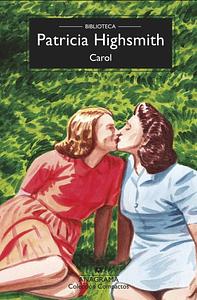Take a photo of a barcode or cover
Objectively I can say that it was well-written.
Historically I can say that it was incredibly important.
Personally I found it to be frustrating and slow. I wanted to like Therese, I really did, but her shrinking violet persona was difficult to really suss out into a likeable character. Carol meanwhile was always too cold and distant to thaw my heart (which for the record is fairly empathetic and pretty warmed up at any given point. The fact that a lesbian love story with a character like Carol could fail to move me much past "mildly interested" on the <3 scale was disappointing.
Historically I can say that it was incredibly important.
Personally I found it to be frustrating and slow. I wanted to like Therese, I really did, but her shrinking violet persona was difficult to really suss out into a likeable character. Carol meanwhile was always too cold and distant to thaw my heart (which for the record is fairly empathetic and pretty warmed up at any given point. The fact that a lesbian love story with a character like Carol could fail to move me much past "mildly interested" on the <3 scale was disappointing.
Avevo trovato blando l'adattamento cinematografico di Todd Haynes, e neppure il romanzo mi ha particolarmente scossa.
what is there to say? I did it, I moved to a bigger city
Patricia Highsmith puts forward an account of love which doesn't follow the usual machinations of romance, the ones that possess people to fill up expensive restaurants on Valentine's Day - the ones which trade solely on the currency of happiness, leaving in its wake an impoverished sadness. In Highsmith's account there is this happiness/sadness too, but there is another dimension: there is fear and courage. Highsmith's writing is genius unapparent - her prose is exacting, her turns of phrase economical at best, but she writes emotion into her characters with such physicality, one cannot help but be moved. Highsmith writes fear into love, acknowledging its unpredictability, the electric quality love takes on when eyes meet across a room. But she also populates Carol's world with a fear of love, the insistent danger of homophobia that threatens both relationships and a sense of self. Highsmith's solution is courage - in a favourite line, Carol writes to Therese: "I remember your courage that I hadn't suspected, and it gives me courage." In Carol, Highsmith manages to hold on to a story of love that runs the depth of our humanity. She listens with an ear to the floorboards to even the most insistent parts of us that both terrify and console, and has a masterpiece to show for it.
challenging
dark
emotional
sad
tense
slow-paced
Plot or Character Driven:
Character
Strong character development:
Complicated
Loveable characters:
No
Diverse cast of characters:
No
Flaws of characters a main focus:
Yes
emotional
hopeful
reflective
medium-paced
Plot or Character Driven:
Character
Strong character development:
Yes
Loveable characters:
Yes
Diverse cast of characters:
No
Flaws of characters a main focus:
Complicated
Therese kept her voice on the same level. "Were you ever in love with a boy?"
"A boy?" Richard repeated, surprised.
"Yes."
Perhaps five seconds passed before he said, "No," in a positive and final tone.
At least he troubled to answer, Therese thought. What would you do if you were, she had an impulse to ask, but the question would hardly serve a purpose. She kept her eyes on the kite. They were both looking at the same kite, but with different thoughts in their minds. "Did you ever hear of it?" she asked.
"Hear of it? You mean people like that? Of course." Richard was standing straight now, winding the string in with figure-of-eight movements of the stick.
Therese said carefully, because he was listening, "I don't mean people like that. I mean two people who fall in love suddenly with each other, out of the blue. Say two men or two girls."
It's the early 1950s and although nineteen-year-old Therese lives a rather free life in NYC, living on her own with no family connections, working in a department store for the holidays while she tries to get a break as a set designer, same-sex relationships are still taboo. Richard is her boyfriend, an "artist" from a close-knit Russian family, who believes he loves Therese enough to eventually make her love him. But when Therese meets a beautiful, wealthy customer while working in the toy department (an incident from Ms. Highsmith's real life that inspired this novel), her life takes a completely different direction.
The object of Therese's affection, Carol, is in the midst of a nasty divorce, trying to retain at least partial custody of her only child. In January, facing months without her daughter, Carol invites Therese to join her on a road trip across the country. Their relationship intensifies, but when they realize a private detective is following them, Carol must decide between Therese and her daughter.
Alternately known as The Price of Salt as originally published under the pseudonym Claire Morgan and Carol when reissued under Ms. Highsmith's real name, this novel is a fascinating character study of two women from very different backgrounds, but both caught by the social mores of their time. It's also a glimpse at just how far we've come in the past 70 years, especially considering that its ending, where the same-sex lovers weren't killed or punished for their transgressions, was revolutionary at the time.
"A boy?" Richard repeated, surprised.
"Yes."
Perhaps five seconds passed before he said, "No," in a positive and final tone.
At least he troubled to answer, Therese thought. What would you do if you were, she had an impulse to ask, but the question would hardly serve a purpose. She kept her eyes on the kite. They were both looking at the same kite, but with different thoughts in their minds. "Did you ever hear of it?" she asked.
"Hear of it? You mean people like that? Of course." Richard was standing straight now, winding the string in with figure-of-eight movements of the stick.
Therese said carefully, because he was listening, "I don't mean people like that. I mean two people who fall in love suddenly with each other, out of the blue. Say two men or two girls."
It's the early 1950s and although nineteen-year-old Therese lives a rather free life in NYC, living on her own with no family connections, working in a department store for the holidays while she tries to get a break as a set designer, same-sex relationships are still taboo. Richard is her boyfriend, an "artist" from a close-knit Russian family, who believes he loves Therese enough to eventually make her love him. But when Therese meets a beautiful, wealthy customer while working in the toy department (an incident from Ms. Highsmith's real life that inspired this novel), her life takes a completely different direction.
The object of Therese's affection, Carol, is in the midst of a nasty divorce, trying to retain at least partial custody of her only child. In January, facing months without her daughter, Carol invites Therese to join her on a road trip across the country. Their relationship intensifies, but when they realize a private detective is following them, Carol must decide between Therese and her daughter.
Alternately known as The Price of Salt as originally published under the pseudonym Claire Morgan and Carol when reissued under Ms. Highsmith's real name, this novel is a fascinating character study of two women from very different backgrounds, but both caught by the social mores of their time. It's also a glimpse at just how far we've come in the past 70 years, especially considering that its ending, where the same-sex lovers weren't killed or punished for their transgressions, was revolutionary at the time.
emotional
tense
medium-paced
Plot or Character Driven:
Character
Strong character development:
Yes
Loveable characters:
Complicated
Diverse cast of characters:
Complicated
Flaws of characters a main focus:
Yes
(Spoiler, ja) Der Leseprozess war für mich anstrengend. Das Lesen hat mich derart gestresst, weil es dem Inhalt entspricht. Um 1950 wurden homosexuelle Beziehungen auch in New York noch nicht akzeptiert.
Ich dachte bis zum letzten Kapitel, dass das Buch das Schlechteste war, das ich seit langer Zeit gelesen habe. Aber: die historische Einordnung homosexueller Liebe ist so gut gelungen, dass der Stress, dem die Protagonistin ausgesetzt ist, auf mich als Leserin übertragen wurde. Es werden Aspekte wie Homosexualität als Phase, Homosexualität als schamhaftes Verlangen, als psychische Verirrung dargestellt. Und diese Bewertungen werden von insbesondere einer der Protagonistin nahestehenden Person getätigt, die vorgibt diese eig. bedingungslos zu lieben.
Ein weiterer Aspekt, der das Lesen anstrengend macht, ist die Beziehung der zwei Frauen. Im Grunde wird die Beziehung mit extremem Machtgefälle zwischen den Liebenden dargestellt, das erst im letzten Kapitel und für meinen Geschmack zu kurz reflektiert wird. Des Weiteren ist die grundsätzliche Anziehung zwischen den Frauen unverständlich für Leser:innen, weil sie sehr oberflächlich beschrieben wird. Die Teilaspekte, die detailreicher beschrieben werden, sind für Leser:innen nicht zu decodieren, weil man eben nur eine objektive Betrachterrolle zugeschrieben bekommt.
3 Sterne, weil die zeitliche Einordnung homosexueller Liebe extrem gut gelungen ist und auf eine Art ergreifend war, dass ich sie erst nicht anerkennen konnte. 3 Sterne, weil die Liebesgeschichte der zwei Frauen aus meiner Perspektive einfach nicht zeitgemäß ist und eher eine heterosexuelle Beziehung nachahmen will, anstatt sich von dieser Erwartung zu emanzipieren, so wie ich (und ich bin mir bewusst, dass es Gegenpositionen gibt) gesunde Liebesbeziehungen verstehe.
Ich dachte bis zum letzten Kapitel, dass das Buch das Schlechteste war, das ich seit langer Zeit gelesen habe. Aber: die historische Einordnung homosexueller Liebe ist so gut gelungen, dass der Stress, dem die Protagonistin ausgesetzt ist, auf mich als Leserin übertragen wurde. Es werden Aspekte wie Homosexualität als Phase, Homosexualität als schamhaftes Verlangen, als psychische Verirrung dargestellt. Und diese Bewertungen werden von insbesondere einer der Protagonistin nahestehenden Person getätigt, die vorgibt diese eig. bedingungslos zu lieben.
Ein weiterer Aspekt, der das Lesen anstrengend macht, ist die Beziehung der zwei Frauen. Im Grunde wird die Beziehung mit extremem Machtgefälle zwischen den Liebenden dargestellt, das erst im letzten Kapitel und für meinen Geschmack zu kurz reflektiert wird. Des Weiteren ist die grundsätzliche Anziehung zwischen den Frauen unverständlich für Leser:innen, weil sie sehr oberflächlich beschrieben wird. Die Teilaspekte, die detailreicher beschrieben werden, sind für Leser:innen nicht zu decodieren, weil man eben nur eine objektive Betrachterrolle zugeschrieben bekommt.
3 Sterne, weil die zeitliche Einordnung homosexueller Liebe extrem gut gelungen ist und auf eine Art ergreifend war, dass ich sie erst nicht anerkennen konnte. 3 Sterne, weil die Liebesgeschichte der zwei Frauen aus meiner Perspektive einfach nicht zeitgemäß ist und eher eine heterosexuelle Beziehung nachahmen will, anstatt sich von dieser Erwartung zu emanzipieren, so wie ich (und ich bin mir bewusst, dass es Gegenpositionen gibt) gesunde Liebesbeziehungen verstehe.






